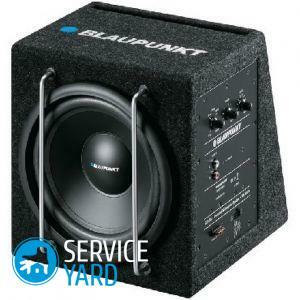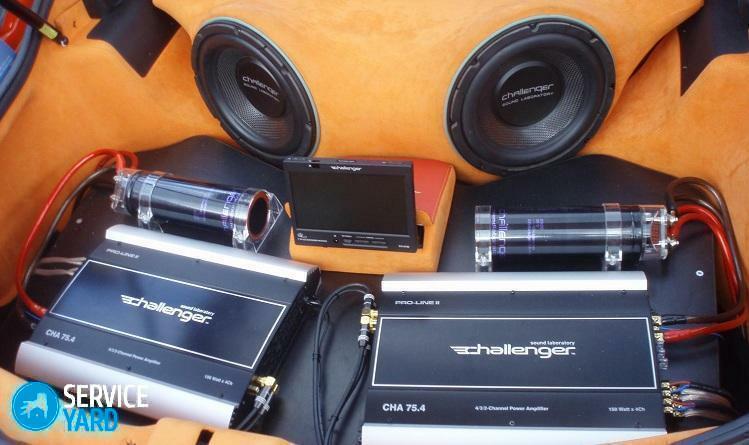
- Choosing an amplifier
- Power
- Frequency range
- Class
- Number of channels
Many car enthusiasts like to please themselves with good sound. Are you an exception? Then this article just suits you. Today we will talk about how to choose an amplifier for a subwoofer. Is it difficult to choose the right device? What are the subtleties of choice? The answer to this and other questions you can find here.
to the contents ↑Choosing an amplifier
A subwoofer is known to be needed for low frequencies, without it any music seems not so lively and immersive. But if you really want to achieve quality, you need to choose the right amplifier for the "roll".But the pursuit of quality has its price, you need to take into account all possible risks and costs and only then go directly to the choice.
to the contents ↑Power of the
Which amplifier is better for a subwoofer? In order to choose the right amplifier, you first need to get acquainted with the three most common opinions:
- The power of the selected device should be less than the power of the subwoofer to avoid the occurrence of overloads on the speaker.
- Capacities must be equal.
- The amplifying device must have a high power.
Where is the truth? Let's sort it out a little.
Amplifier is weaker than the subwoofer
When selecting the resistance value, you need to understand that the amplifier should work at this load, now you can take on power. We need to know the value of the nominal power. The speaker should work stably on such values without any disastrous consequences. For the amplifier, this is the maximum power at which the level of distortion is acceptable.
There are nuances for both the speaker and the amp. The speaker can be damaged by mechanical or thermal effects, if not all at once. With a mechanical action, the mobile system fails. In order to avoid this, it is necessary to correctly select the values of the maximum stroke of the cone. It should not exceed twenty percent.
The thermal effect is manifested in the system overheating, which can occur for the following reasons:
- Amplifier clipping. The reason for this problem is the lack of power of the device. In other words, you add the volume of the sound, and the amplifier begins to "choke" and give out harmonics, sending a lot of high frequencies to the speaker. The voice coil very quickly overheats and burns if you do not turn down the volume.
- Motion of the coil outside the working gap of the magnetic system. If the coils of this coil come out of the working gap, all the energy of the device will go to heat the coil. Before overheating, of course, it will come slower, but you can not follow, losing the speaker.
Important! It is advisable not to listen to tracks with very low frequencies. It is at these frequencies that it is possible to destroy the movement by a signal even of low power, albeit considerably less than the nominal one.
Do not think that the selection of an amplifier to a subwoofer will now stall. The main thing in this business is to understand all the nuances.

Capacities are equal to
This case also does not bode well. Most often, the nominal power of the amp is regulated for a supply voltage that is 14.4 volts. Unfortunately, real conditions do not allow to keep such voltage on the terminals of the device.
The amplifier will immediately go into the clip, not even approaching its nominal power. In this case, the voice coil will be under threat.
Amplifier has a large power
So which amplifier is better for a subwoofer? Sometimes, you can see devices with values of one and a half or even two times higher. But is it worth it to be afraid of mechanical damage in this case? Of course, but only if you firmly decided to make fun of the speaker. But to do this, of course, is not worth it. If you do not output the speaker to the maximum and do not get carried away with songs with very low frequencies, life will be long and happy.
Well then. So we came to the conclusion that it's impossible to protect yourself from all sides, and the main thing in this business is to have a head on your shoulders. But if you look at the statistics, then the third option is the most optimal, since the speaker in this case will live longer.
to the contents ↑Frequency range
Power is not the only criterion for choice, nor is it the only important parameter. It is the frequency range that is responsible for the spread. Most often on the goods values equal to approximately 15-350 Hz.
Important! The numbers that are strikingly higher than the mean values are the trend of marketers. Such a device may work at such frequencies, but the sound quality is questioned.
to the contents ↑Class
The amplifier class is also an important parameter. Modern instruments can be divided into two known types:
- AB.This is an analog device, which has excellent quality of amplification, but is characterized by rather small indicators of efficiency and power.
- D-type. A digital amplifier with good efficiency, but a lame quality.
Which amplifier is best for a subwoofer if you select it by class? Only you can answer this question. Everything depends on the desired result and means.
to the contents ↑Number of channels
Also an important parameter for selection. We classify the device according to the following criteria:
- Single-channel. Monoblock is a simple language. Such devices withstand the load only at low values (somewhere a couple of Ohms).These amplifiers are suitable for owners of professional audio systems, power which is one of the main indicators. Most often these are gadgets of the D-class.
- Two-channel. Such devices are easy to install with subwoofers that are rated from four to eight ohms. The connection is carried out using a bridge circuit or a coil.
- Three-channel. These devices can boast of leading representatives: Eton SR 100.2 or Genesis Profile Two. But such devices are harder to find because of the lost relevance.
- Four-channel. Such amplifiers can be easily used for at least four speakers and a subwoofer or for several quality "rolls."Installation and operation rarely raises questions, which makes such gadgets extremely popular.
- Five-channel. Also have great popularity, because an additional subwoofer channel allows you to use both front and rear acoustics. A clear advantage is the price and small size.
- Six-channel. To find such an apparatus is extremely rare, since the systems that exist now are not so demanding on the amplifying elements.
Some drivers focus on sensitivity, but this option is usually neglected.


